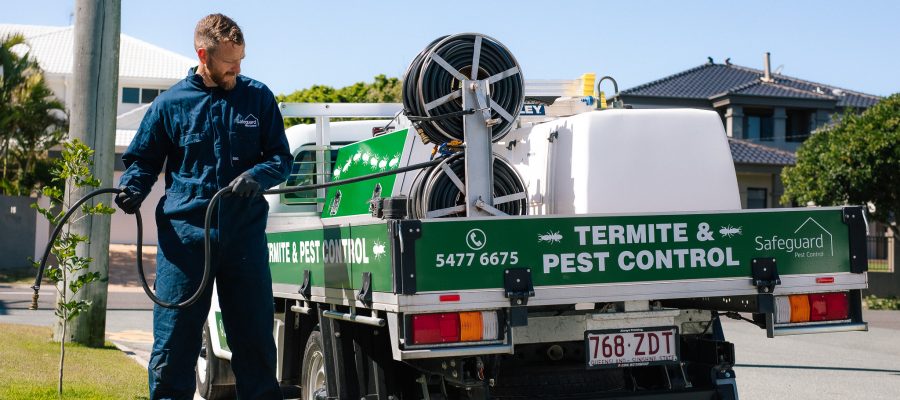5 Things You Need To Know About Pest Control Spray
- August 2, 2021
- in Pest Control
- by Ashley Dando

Pests running havoc in your home can be a danger to both your health and your peace of mind. Termites can cause substantial damage to your walls and floor. Cockroaches and mice carry diseases.
If you don’t deal with the problem early on, you’ll need to seek professional help.
Ridding your home of an infestation can prove borderline impossible on your own. A pest control spray is one of the many options available to homeowners to protect their homes or business.
However, you can’t just expect pest control to walk into your home and solve your problem without preparation. Here are five things you need to know about pest control spray before calling in the cavalry.
First, you should be aware of the different types of pest control sprays available and what they’re used for.
Chemical sprays are what most people associate with pest control. These pesticides kill off populations in various different ways.
Some chemical sprays kill pests as soon as they make contact. An example of this is a standard roach spray you can buy from any general store. They can become inert shortly after use or linger for a longer period of time to protect from future pests.
A biological pest control spray controls and eliminates pests using other organisms. These are often used on garden plants to manage bugs without harming the plants with toxic chemicals.
One example of a biological alternative is seeding your plants with ladybugs. Ladybugs prey on harmful insects but are otherwise harmless. You can also purchase certain bacteria that kill caterpillars when exposed to them.
There are some things you’ll need to do in your home before pest control gets there to get the best results.
First of all, relocate any pets you have before treatment begins. The chemicals they may use can be toxic to all animal life, so make sure they’re in a safe space for the day.
You’ll then want to protect any items that you want to avoid contact with chemicals. This includes clothes, toys, toiletries, and more. Store or seal them away, and clean any fabrics.
Once that’s done, move your furniture around to grant easy access for your exterminators. Furniture and appliances should be moved away from the walls, where pests may be hiding.
Even when pest control finishes up, that doesn’t necessarily mean the building is completely safe to enter yet.
Depending on the type of pest control used, the exterminators should give you a set amount of time to wait before going back in. They may need time for the building to completely vent out.
Even though you may be concerned about traces of chemicals left around your home, don’t worry too much. Pest control professionals should have cleaned up behind themselves. In some cases, cleaning off counters or mopping the floor can actually work against the treatment.
In the days after you’ve received treatment, expect to see dead pests pop up throughout your home. You may be surprised at the number you find when you wake up the next morning.
Make sure to dispose of any dead pests you see, as they can attract other pests.
When pest control services come to deal with an infestation, they advise you to vacate the premises. That’s because chemical pesticides are toxic and can cause a number of health effects from exposure.
Some of those health effects include irritation at best, and damage to your central nervous system at worst. You can get headaches and dizziness, and long-term exposure can even give you an increased risk of cancer.
Pest control spray is typically used as a spot treatment option, as opposed to a bug bomb that affects your entire house. However, you can still develop issues if you spend time near the locations that were sprayed.
If you’re using pest control sprays on your own, always make sure to stick to the manufacturer’s directions. Mix or dilute the chemicals outdoors and apply as needed. Open some windows to vent out the area and keep unused pesticides outside of the building.
When in doubt, call in a pest control service that sprays pest control for you. They’re certified to use more effective chemicals and can protect you from exposure.
A general pest control treatment can last for a few months after it’s applied. In that time, you’ll see much fewer insects than before. However, you shouldn’t rely solely on pest control sprays to keep your space pest-free.
There are a number of reasons why pests start showing up in your home. Leftover food and standing water can attract them. You may also have a door or window that isn’t shutting properly.
Be sure to look for problems outside of your building as well. Termites, especially, are attracted to moisture and deadwood. By the time you’ve noticed them outside, they could already be in your walls.
Take care of the reasons they’re showing up before and after you seek professional help. It won’t matter how effective a pest control spray is if you don’t take the precautions to prevent more infestations in the future.
There’s only so much a person can do to keep pests out of their home and workplace. Roaches can be sprayed, but there could be many more lurking in the walls that you can’t reach. And termites are an entirely different problem altogether.
Pest control spray is a great option for fighting an infestation. You can use it to get in all the nooks and crannies where pests like to hide, and it lasts for months.
Contact us at Safeguard Pest Control for a free estimate and same-day service for buildings along the Sunshine Coast.